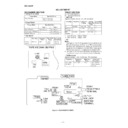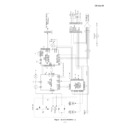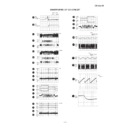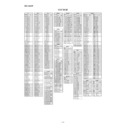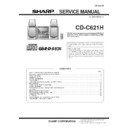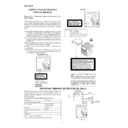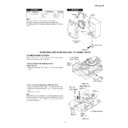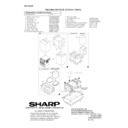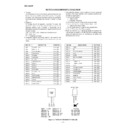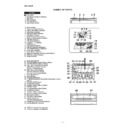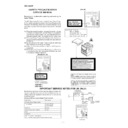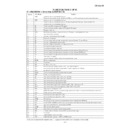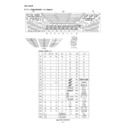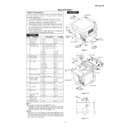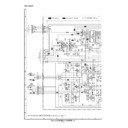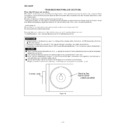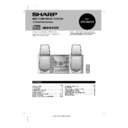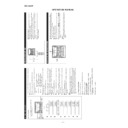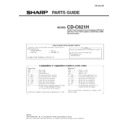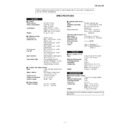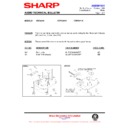Read Sharp CD-C621H (serv.man19) Service Manual online
CD-C621H
– 10 –
MECHANISM SECTION
ADJUSTMENT
Figure 10 ADJUSTMENT POINTS
•
Driving Force Check
Torque Meter
Specified Value
Play: TW-2412
Tape 1: Over 80 g
Tape 2: Over 80 g
Tape 2: Over 80 g
•
Torque Check
Torque Meter
Specified Value
Tape 1
Tape 2
Play: TW-2111
30 to 60 g. cm
30 to 60 g.cm
Fast forward: TW-2231
—
60 to 120 g.cm
Rewind: TW-2231
—
60 to 120 g.cm
•
Tape Speed
Test Tape
Adjusting
Point
Specified
Value
Instrument
Connection
Normal
MTT-111
VRM1
3,000
±
Speaker
speed
30 Hz
terminal
TUNER SECTION
fL: Low-range frequency
fH: High-renge frequency
fH: High-renge frequency
•
AM IF/RF
Signal generator: 400 Hz, 30%, AM modulated
Test Stage
Frequency
Frequency
Display
Setting/
Adjusting
Parts
Instrument
Connection
IF
450 kHz
1,620 kHz
T351
*1
MW Band
—
522 kHz
(fL): T306
*2
Coverage
1.1
±
0.1 V
MW
990 kHz
990 kHz
(fL): T302
*1
Tracking
*1. Input: Antenna,
Output: TP302
*2. Input: Antenna,
Output: TP301
• FM
Notes:
1: Description of the "FM IF Adjustment" is not carried on this
Notes:
1: Description of the "FM IF Adjustment" is not carried on this
Manual. It is because the IF coil in the FM front end section
has been best adjusted in the factory so that its further
adjustment is not needed at the field. When replacing the
FM front end assembly, no adjustment is needed either.
has been best adjusted in the factory so that its further
adjustment is not needed at the field. When replacing the
FM front end assembly, no adjustment is needed either.
2: The parts in the FM front end section are prepared in a
complete unit, so you can't obtain each part individually
Adjusting
Parts
Instrument
Connection
Frequency
Display
Frequency
• FM Mute Level
Signal generator: 1 kHz, 40 kHz dev., FM modulated
Signal generator: 1 kHz, 40 kHz dev., FM modulated
98.00 MHz
98.00 MHz
VR351
Input: Antenna
(25 dB
µ
V)
Output: Speaker
Terminal
Terminal
VRM1
TAPE
SPEED
SPEED
FAS
SW
SW
SWM1
TAPE MECHANISM PWB
TP302
R357
L354
T351
VR351
FM MUTE
LEVEL
LEVEL
R336
TP301
FE301
T306
T302
L341
SO301
FM ANTENNA
TERMINAL
FM ANTENNA
TERMINAL
CNP301
MW LOOP
ANTENNA
TERMINAL
MW LOOP
ANTENNA
TERMINAL
TUNER PWB
CNP303
AM IF
MW BAND
COVERAGE
COVERAGE
MW
TRACKING
TRACKING
– 11 –
CD-C621H
TEST MODE
Figure 11-2
Figure 11-3
Since this CD system incorporates the following automatic adjustment function, when the pickup is replaced, it is not necessary
to readjust it.
Since this CD unit does not need adjustment, the combination of PWB and laser pickup unit is not restricted.
to readjust it.
Since this CD unit does not need adjustment, the combination of PWB and laser pickup unit is not restricted.
• Automatic adjustment item
1. Focus offset (Fig. 11-2)
2. Tracking offset (Fig. 11-3)
3. E/F balance (tracking error balance) (Fig. 11-4)
4. RF level AGC function (HF level: constant)
5. RF level automatic follow-up of the tracking gain
1. Focus offset (Fig. 11-2)
2. Tracking offset (Fig. 11-3)
3. E/F balance (tracking error balance) (Fig. 11-4)
4. RF level AGC function (HF level: constant)
5. RF level automatic follow-up of the tracking gain
This automatic adjustment is performed each time a disc is changed. Therefore,
each disc is played back using the optimal settings.
each disc is played back using the optimal settings.
CD SECTION
Figure 11-1
Note:
Only in STOP state it is possible to slide the pickup with the (
) or (
) key.
VOL. --- Last memory
BAL. --- CENTER
R.GEQ. --- FLAT
X-BAS --- OFF
BAL. --- CENTER
R.GEQ. --- FLAT
X-BAS --- OFF
Canceling method - POWER OFF
• Setting the test mode
Any one of test mode can be set by pressing several keys as follows.
<REC. PAUSE> + <DISC. SKIP> + <POWER> TEST: CD operation test
• TEST mode
Function — CD test mode
Any one of test mode can be set by pressing several keys as follows.
<REC. PAUSE> + <DISC. SKIP> + <POWER> TEST: CD operation test
• TEST mode
Function — CD test mode
Setting of TEST mode
Indication of CD TST mode (Fig. 11-1)
OPEN/CLOSE operation is manual operation.
The pickup can be moved by using the (
) or (
) key.
<MEMORY>
LASER ON
LASER ON
<PLAY> key input
Press <STOP> key.
Stop
TOC. IL is performed, and the ordinary PLAY is performed.
If the following key is pressed during PLAY, it is possible
to specify directly any Track No.
<Disc Number 1> key: Track 4
<Disc Number 2> key: Track 9
<Disc Number 3> key: Track 15
If the following key is pressed during PLAY, it is possible
to specify directly any Track No.
<Disc Number 1> key: Track 4
<Disc Number 2> key: Track 9
<Disc Number 3> key: Track 15
<MEMORY>
Tracking on the spot.
SERVO OFF PLAY
Tracking on the spot.
SERVO OFF PLAY
<MEMORY>
Tracking on the spot.
SERVO ON PLAY
SERVO ON PLAY
STOP
Figure 11-4
IL is not performed.
<STOP>
1
2
3
2
0.1s
0.50 V
IC1 20 FE
0.50 V
IC1 20 FE
0.1s
0.50 V
IC1 7 TE
0.50 V
IC1 7 TE
1
FOCUS
OFF-SET
ADJUST
OFF-SET
ADJUST
TRACKING
OFF-SET
ADJUST
OFF-SET
ADJUST
2
1
10ms
0.50 V
IC1 20 FE
0.50 V
IC1 20 FE
10ms
0.50 V
IC1 7 TE
0.50 V
IC1 7 TE
Enlarged
View
View
TRACKING
OFF-SET
ADJUST
OFF-SET
ADJUST
2
1
TO
TE
200 ms
1V/diV
IC 1 15
1V/diV
IC 1 15
200 ms
1V/diV
IC 1 7
1V/diV
IC 1 7
TRACKING/
ERROR
BARANCE
ADJUST
ERROR
BARANCE
ADJUST
CD-C621H
– 12 –
No
ASPM, summary operation
Hold down the
ASPM button for 3 more second.
“ASPM” blinks in the display
.
Preset CH memory full over?
No operate.
After displayed “END”. Return to
previous station.
SD (TUNE) DET out OK?
If count 1st OK?
If count 2nd OK?
RDS signal or not? PI—identify
Comparing PI cord same or not?
between current receiving PI and
before PI which is already memorized
by
ASPM on this time.
Comparing freg. same or not?
between current receiving frequency
and (already) previously memorized
frequency
.
Memorized to the lowest
vacant preset channel.
Preset CH memory become full over?
Begin to
ASPM SCAN from the next
CH-SP
AN again.
Repeat and continue with same format
ASPM operation untill 108 MHz.
After reached 108 MHz, displayed the
TTL quantity of memorized stations.
And return to the previous receiving
freq. automatically
.
Displayed the
TTL
quantity of memo-
rized stations by
ASPM operation on
this time.
And return to the previous
receiving freq. automatically
.
Ye
s
No
Ye
s
Ye
s
Ye
s
Ye
s
No
No
No
No
No
No
Ef
fect
Pass
No ef
fect
Pass
No ef
fect
Pass
No ef
fect
Pass
No ef
fect
Ye
s
No
Ye
s
Compare the field strength of current
receiving signal. Is receiving signal
stronger than signal which has same PI
cord and is already memorized to
preset memory ahead of this receiving
time?
Ye
s
No ef
fect
No
No ef
fect
Comparing freg. same or not?
Between current receiving frequency
and (already) previously memorized
frequency
.
Ye
s
Memorized to the lowest
vacant preset channel.
Ye
s
No ef
fect
Begin to scan start 87.50
→
108.00 MHz
– 13 –
CD-C621H
4. No adjust type (None adjusting circuit.)
5. Added EON button.
6. Need to change RDS logo due to add EON feature.
7. Added EON—TI, EON—PTY function.
5. Added EON button.
6. Need to change RDS logo due to add EON feature.
7. Added EON—TI, EON—PTY function.
3. Summary of CD-C621H RDS—EON operation
EON—PTY: Select and set the desired “PTY”
→
stand-by
→
switch to ON (other network) Station at the start of desired PTY
automatically
→
stay and listen to PTY of ON station
→
switch back to TN (This net) station automatically at the end
of PTY (ON) i.e. after changing to another PTY (except AF M FAIRS) or cancelling to receive PTY of ON station
midway.
midway.
EON—TI:
Select and set the “TI”
→
stand-by
→
switch to ON station at the start of traffic announcement automati cally
→
stay
and listen to TA of ON station
→
switch back to TN station autmatically at the end of TA (ON).
ie after TA (ON) is over or cancelled to receive TA of ON station midway.
When switching TN
When switching TN
→
ON station.
In case of exist 2 more stations having the desired (specified) “PTY” or “TI”, the receiver will select and switch to ON station
comparing field strength at the same time. But when the frequency of ON station exists in the preset-memory, then reciver
switches straight to that ON station (CH), without comparing field strength so can make a quick switching from TN—ON station.
Preset memory takes priority of switching TN—ON station.
Therefore ASPM is usefull not only for PTY search but also for rapid EON switching.
Anyway CD-C621H EON is basically stand-by and receiving method, along with the Guidelines for EON implementation.
comparing field strength at the same time. But when the frequency of ON station exists in the preset-memory, then reciver
switches straight to that ON station (CH), without comparing field strength so can make a quick switching from TN—ON station.
Preset memory takes priority of switching TN—ON station.
Therefore ASPM is usefull not only for PTY search but also for rapid EON switching.
Anyway CD-C621H EON is basically stand-by and receiving method, along with the Guidelines for EON implementation.
• ASPM SCAN: 87.50MHz
→
108.00 MHz.
• Only RDS signal is memorized by ASPM because RDS signal has PI code and is suitable and convenient for ASPM operation.
ASPM
Comparing field strength, only one strongest RDS station is memorized of all stations (repeater relay stations) that have same
ASPM
Comparing field strength, only one strongest RDS station is memorized of all stations (repeater relay stations) that have same
PI code.
Same PI code — freq: different
(AF’S)
PS: same
PTY: same
PTY: same
Each PI has AF’S list by individually.
Exa: P1 has f
Exa: P1 has f
1
, f
2
, f
3
(same PTY).
P2 has f
4
, f
5
(same PTY).
[For example]
Pickup and memorized to preset CH.
f 1
f 2
f 2
f 3
P 1 (PI cord)
PS 1 (Station Name)
PS 1 (Station Name)
f 5
f 4
P 2
PS 2
PS 2
f 6
f 7
f 7
f 8
P 3
PS 3
PS 3
f 9
f 10
f 11 f 12 f13
P 4
PS 4
PS 4
Select signals (f1, f5, f7, f10) are memorized in the preset memory by ASPM.
• If tentative - ASPM operation is repeated intententionally, never memorized (over write) at the same frequecy.
• If tentative - ASPM operation is repeated intententionally, never memorized (over write) at the same frequecy.
1st time ASPM
→
strongest stations of each pi are memorized.
ASPM is not only very usefull for PTY search, but also EON operation.
2nd time ASPM
2nd time ASPM
→
2nd strong stations of each pi are memorized and so on.
PTY search function is equal to FM band search function as a result.
1. Introduction of RDS for CD-C621H
CD-C621H RDS function is equal to adding EON feature to the current CD-C75H RDS.
EON feature is EON—PTY and EON—TI.
Although PTY and TI indicators are separated, PTY contains TI in the PTY items (software) like current PTY search items.
EON feature is EON—PTY and EON—TI.
Although PTY and TI indicators are separated, PTY contains TI in the PTY items (software) like current PTY search items.
NEWS,
AFFAIRS,
INFO,
ALARM,
TI
(TTL 17 kinds)
EON—PTY
EON—TI
Can select and stand-by
Can select and stand-by
EON—PTY and EON—TI are basically stand-by
→
receive the desired program of ON station.
2. The difference point from current CD-C75H RDS. (CD-C75H — CD-C621H)
1. PTY item: added TA.TTL 18 kind.
2. Each “TP”, “TA” ind. light up or go out individually.
“TA” ind. doesn’t light up on current model, CD-C75H due to none EON—TI.
3. Added 3 indicators(in FL) due to adding EON feature.
EON: Lights up only during receiving EON data (14A).
TI:
2. Each “TP”, “TA” ind. light up or go out individually.
“TA” ind. doesn’t light up on current model, CD-C75H due to none EON—TI.
3. Added 3 indicators(in FL) due to adding EON feature.
EON: Lights up only during receiving EON data (14A).
TI:
During EON-TI stand-by
→
Light up
During receiving ON station.
→
blink.
PTY: During EON-PTY stanb-by
→
Light up
During receiving ON station.
→
blink.
---
---
↑
↑

